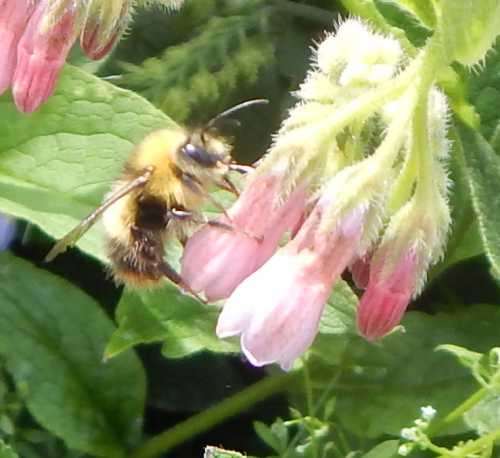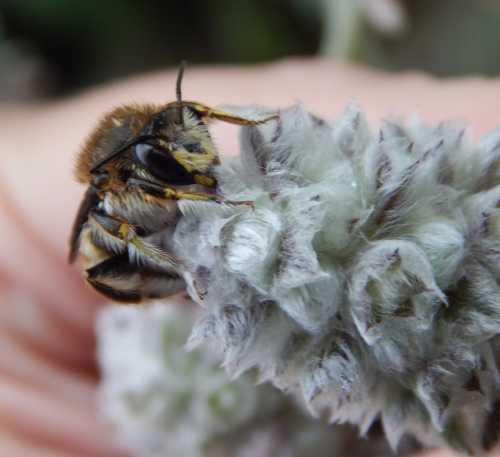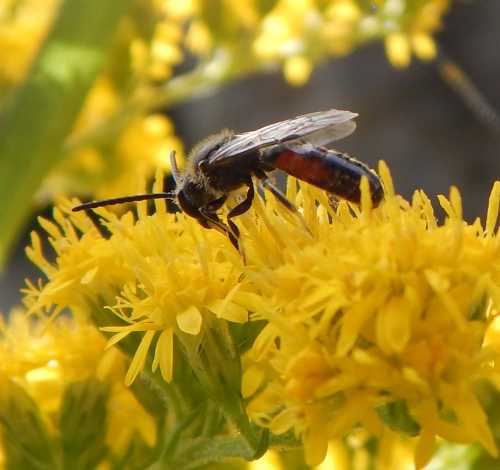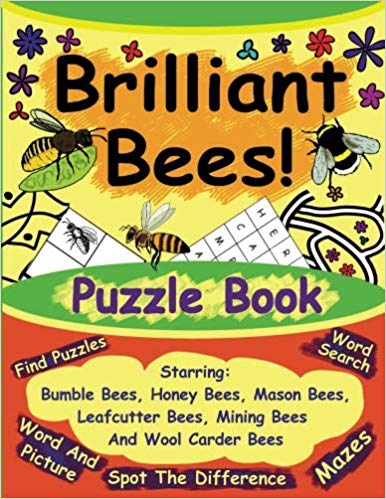The Red Mason Bee - Osmia bicornis
I love mason bees, and have spent much time observing the Red Mason Bees (Osmia bicornis) in my garden. I have captured quite a lot of video footage, including some film of the bees mating, and females emerging from the nest. I share one such video below.
About The Red Mason Bee - Osmia bicornis
The Red Mason bee is a member of the genus ‘Osmia’ which are part of the family ‘Megachilidae’.
Now known as Osmia bicornis, this species was previously known as Osmia rufa. Females have a black head, a brownish thorax, and orangey-brown hair on the thorax and abdomen and measure about 9mm in length. Males are similar but smaller.
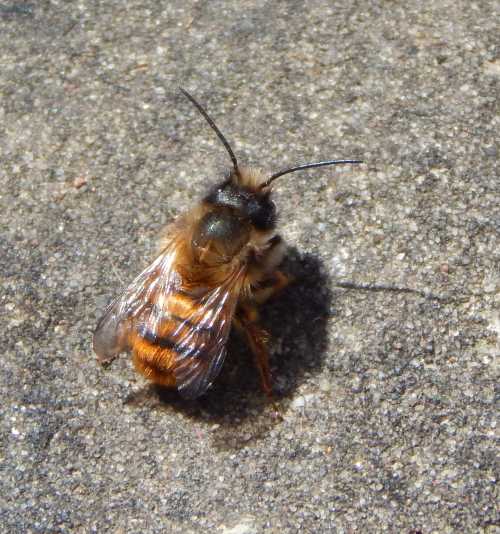 Female red mason bee, Osmia bicornis.
Female red mason bee, Osmia bicornis.Life cycle and mating behaviour of Red Mason Bees
Similar to the leafcutter bee life cycle, adults emerge in spring following a period of development and hibernation in a cell.
Males appear first, waiting eagerly for sight of the females with which they will mate.
 Female Red Mason bee.
Female Red Mason bee.Males patrol and wait around the nest, watching, sometimes 'dive bombing' other males as they wait for the females to appear, whereupon they will pounce immediately and mate. Note males have a pale "moustache" or tuft of hair on their faces, and they are smaller than the darker-faced females.
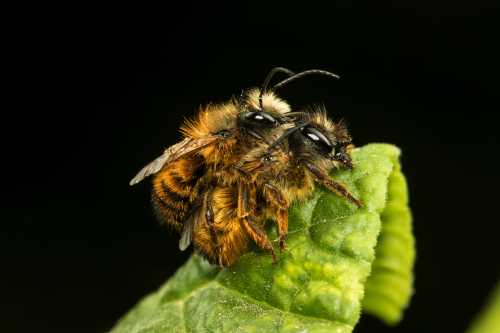 Pair of red mason bees mating
Pair of red mason bees mating
Below is a video taken of Osmia bicornis activity around my mason bee house.
If you watch the video carefully, right at the very beginning you will notice to the top left, 2 males (note pale 'moustache') - one is inspecting the inside of one of the holes, checking for a female, whilst the other male can hardly get a look in! Watch as the female emerges, and quick as a flash, the male has caught her!
Meanwhile to the top right, and on top of the bee house is an amorous pair, already mating for quite some time! With some bee species, the mating process is completed very quickly, but not with this species.
As the camera moves to the hollow canes below you'll see a lovely female, with her sweet little face peeping out of her chosen cane!
After mating....
After mating has taken place, the males will soon die. The female will seek a suitable location for her nest. She then constructs the nest, providing pollen and nectar in each cell for a single larva.
It may take many trips for bees to provide enough pollen for just one egg, and therefore, visits to many flowers are necessary.
Eggs destined to become females are laid toward the back of the nest (as stated, they emerge after the males), whilst males are laid toward the front.
They will usually make between 4 and 6 cells, although sometimes as many as 10. The larvae develop and pupate, emerging as adults the following Spring. Read about the bee life cycle.
Four or five similar nests may be completed in a season. There will be one generation per year.
Red Mason Bee Nests
Along with other Osmia, this species constructs its nest cells in cavities. The females make their nests in existing cracks and crevices in walls, but they also favour hollow plant stems.
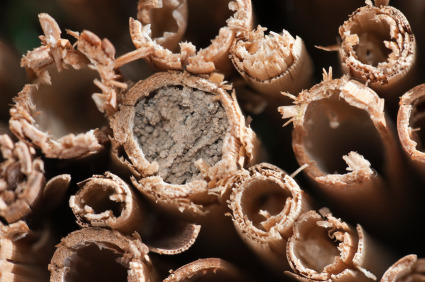
Once a brood cell has been made,
mud is often used to make partitions between each individual cell.
The female uses a pair of ‘horns’ on her face to pack mud to close the cell. The mud they use may be gathered from the edge of a pond, or puddle from where they take small pellets to their nest.
Mason bee houses
For
several years now, we have had the pleasure of watching these wonderful
little pollinators establish nests around our garden, providing excellent entertainment!
Below is a photograph taken of the bee house featured in the video. I received this bee house as a gift.
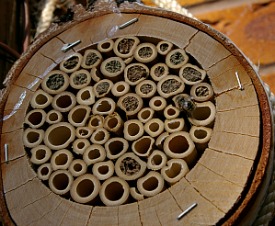
You can also make your own bee house very easily! To encourage them to set up a home, site bundles of hollow canes or a log drilled with holes (do not use chemicals on the log), in a sunny position:
Measurements
Ensure the holes
are around 6mm - 1cm in diameter, and about 15cm long. Ideally, there will be a
source of mud nearby, and plenty of opportunities for foraging.
Materials
Please do not use plastic materials, glass or metal. Such materials can cause overheating, moisture, and related fungal and bacterial diseases, and ultimately death.
Research also suggests that mason bees naturally detect and avoid nest sites with high temperatures (28°C) and often prefer cooler (24°C) or ambient temperatures (average 18–20°C)1. The study found that offspring survival decreases with higher nest temperature, mostly due to mortality (death) at the egg stage. Higher temperatures also led to weight loss in adult bees. It is worth considering this point, especially in view of potential temperatures in the summer.
Additionally, I advise against cedar wood - it apparently has insect repellent properties.
Furthermore, unfortunately, mason bee houses can become infested with pollen mites.
Protecting Red Mason Bees from pollen mites
Some ready-made solitary bee houses are especially designed to allow ease of cleaning, by the use of replaceable carboard tubes. This is helpful because it helps to preserve hygiene and protect the bees from mites (see below), which can be a problem for mason bees.
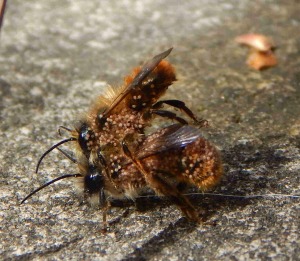 Red mason bees mating, but unfortunately infested with mites.
Red mason bees mating, but unfortunately infested with mites.
Pollen mites pass from bee to bee, dropping off onto flowers, hitching a lift on the next bee, and so being carried to different nest cells, where they breed and eat the bee larvae's food. It is also possible they eat the bee larvae.
You can make or purchase sturdy protective card inserts for use inside a mason bee house, and they are recommended, as they are shown to reduce pollen mite infestation.
If you decide to purchase a mason bee house rather than make your own, you will find that some are designed to look attractive in the garden, and make nice gifts, but I recommend that you do not sacrifice a sturdy, quality build, and think about the needs of the bees first.
Foraging
Many nectar and pollen rich flowers are visited by this species, but to encourage Red mason Bees into your garden, include plenty of spring-flowering plants, trees and shrubs.
They are a significant pollinator of fruit trees, including apple and cherry.
See resources on this website for bee-friendly flowering plants.
References and resources
1. Ostap-Chec, M., Kierat, J., Kuszewska, K. et al. Red mason bee (Osmia bicornis) thermal preferences for nest sites and their effects on offspring survival. Apidologie 52, 707–719 (2021). https://doi.org/10.1007/s13592-021-00858-6
2. Wilson & Messinger Carril - The Bees In Your Backyard, A Guide To North America's Bees, 2016.
3. Falk, Field Guide to Bees Of Great Britain And Ireland, 2015.
If you found this page helpful or interesting, I'd really be grateful if you would share it with others - if not this page, perhaps another, such as Gardening For Bees.
Thank you so much :) .
